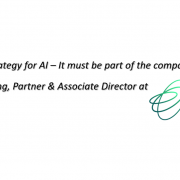Stop processing the same mistakes! Four steps to business & IT alignment
Digitization. Agility. Tech-driven. Just three strategy buzzwords that promise IT transformation and business alignment, but often fade out into merely superficial change. In fact, aligning business and IT still vexes many organizations because company leaders often forget that transformation is not a move from A to B, or even from A to Z––it’s a move from a fixed starting point, to a state of continual change.
Mit den richtigen Prozessen zum Erfolg: vier Schritte zum Business-IT Alignment
Within this state of perpetual flux, adaptive technology is necessary, not only to keep up with industry developments but also with the expansion of technology-enabled customer experiences. After all, alignment assumes that business and technology are separate entities, when in fact they are inextricably linked!
Metrics that matter: From information technology to business technology
Information technology is continuing to challenge the way companies organize their business processes, communicate with customers and potential customers, and deliver services. Although there is no single dominant reorganization strategy, common company structures lean towards decentralizing IT, shifting it closer to end-users and melding the knowledge-base with business strategy. Business-IT alignment is more than ever vital for market impact and growth.
This tactic means as business goals pivot, IT can more readily respond with permanent solutions to support and maintain enterprise momentum. In turn, technological advances and improvements are hardwired into current and future strategies and initiatives. As working ecosystems replace strict organizational structures, the traditional question “Which department do you work in?” has been replaced by, “How do you work?”
But how does IT prove its value and win the trust of the C-suite? Well, according to Gartner, almost 20% of companies have already invested in tools capable of monitoring business-relevant metrics, with this number predicted to reach 60% by 2021. The problem is many infrastructure and operations (I&O) leaders don’t know where to begin when initiating an IT monitoring strategy.
Reach beyond the everyday: Four challenges to alignment
With this, CIOs are under mounting pressure to address digital needs that grow and transform, as well as to renovate the operational environment with new functions. They also must still demonstrate how IT is meeting a given business strategy. So looking forward, no matter how big or small your business is, technology can deliver tangible and intangible benefits (like speed and performance) to hit revenue and operational targets efficiently, and meet your customers’ expectations of innovation.
Put simply, having a good technological infrastructure enriches the culture, efficiency, and relationships of your business.
Business and IT alignment: The rate of change
This continuous strategic loop means enterprises function better, make more profit, and see better ROI because they achieve their goals with less effort. And while there may be no standard way to align successfully, an organization where IT and business strategy are in lock-step can further improve agility and operational efficiencies. This battle of the ‘effs’, efficiency vs. effectiveness, has never been so critical to business survival.
In fact, successful companies are those that dive deeper; such is the importance of this synergy. Amazon and Apple are prime examples—technology and technological innovation is embedded and aligned within their operational structure. In several cases, they created the integral technology and business strategies themselves!
Convergence and Integration
These types of aligned companies have also increased the efficiency of technology investments and significantly reduced the financial and operational risks associated with business and technical change.
However, if this rate of change and business agility is as fast as we continually say, we need to be talking about convergence and integration, not just alignment. In other words, let’s do the research and learn, but empower next-level thinking so we can focus on the co-creation of “true value” and respond quickly to customers and users.
Granular strategies
Without this granular strategy, companies may spend too much on technology without ever solving the business challenges they face, simply due to differing departmental objectives, cultures, and incentives. Simply put, business-IT alignment integrates technology with the strategy, mission, and goals of an organization. For example:
- Faster time-to-market
- Increased profitability
- Better customer experience
- Improved collaboration
- Greater industry and IT agility
- Strategic technological transformation
Hot topic
| View webinar recording Empowering Collaboration Between Business and IT, with Fabio Gammerino, Signavio Pre-Sales Consultant. |
The power of process: Four steps to better business-IT alignment
While it may seem intuitive, many organizations struggle to achieve the elusive goal of business-IT alignment. This is not only because alignment is a cumbersome and lengthy process, but because the overall process is made up of many smaller sub-processes. Each of these sub-processes lacks a definitive start and endpoint. Instead, each one comprises some “learn and do” cycles that incrementally advance the overall goal.
These cycles aren’t simple fixes, and this explains why issues still exist in the modern digital world. But by establishing a common language, building internal business relationships, ensuring transparency, and developing precise corporate plans of action, the bridge between the two stabilizes.
Four steps to best position your business-IT alignment strategy:
- Plan: Translate business objectives into measurable IT services, so resources are effectively allocated to maximize turnover and ROI – This step requires ongoing communication between business and IT leaders.
- Model: IT designs infrastructure to increase business value and optimize operations – IT must understand business needs and ensure that they are implementing systems critical to business services.
- Manage: Service is delivered based on company objectives and expectations – IT must act as a single point-of-service request, and prioritize those requests based on pre-defined priorities.
- Measure: Improvement of cross-organization visibility and service level commitments – While metrics are essential, it is crucial that IT ensures a business context to what they are measuring, and keeps a clear relationship between the measured parameter and business goals.
Signavio Says
| Temporarily rotating IT employees within business operations is a top strategy in reaching business-IT alignment because it circulates company knowledge. This cross-pollination encourages better relationships between the IT department and other silos and broadens skill-sets, especially for entry-level employees. Better knowledge depth gives the organization more flexibility with well-rounded employees who can fill various roles as demand arises. |
Get in touch
Discover how Signavio can lead your business to IT transformation and operational excellence with the Signavio Business Transformation Suite. Try it for yourself by registering now for a free 30-day trial.








Leave a Reply
Want to join the discussion?Feel free to contribute!